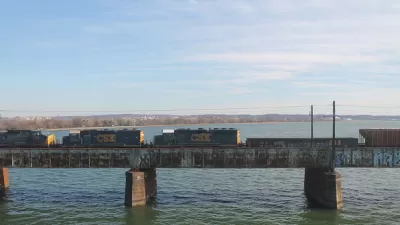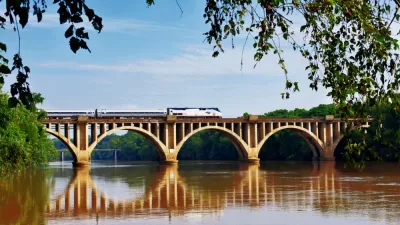McClatchy's Curtis Tate reports on Amtrak routes in Missouri and Kansas. Reduced ridership on the Missouri River Runner may be the result of falling gas prices.
As gas prices drop, we know that fuel efficiency of the new vehicles purchased decreases, while vehicle-miles-traveled and traffic deaths increase. As for public transit, it may be too early to tell whether ridership decreases, but some early signs say it does.
It's also too early to tell if cheap gas will have the same effect on Amtrak ridership, though a report from Missouri may be telling.
"Missouri’s state-supported River Runner between St. Louis and Kansas City [...] lost 10,000 riders from 2014 to 2015, with about 179,000 for the year that ended Sept. 30," writes Curtis Tate, Washington correspondent for McClatchyDC,
Amtrak may be facing some competition with lower gasoline prices. In both Missouri and Kansas, prices are about 24 cents below what they were a year ago, according to AAA. The current U.S. average price is $1.99 a gallon, compared to $2.29 a year ago.
“When gas prices go down, we do see ridership fall some,” said Kristi Jamison, railroad operations manager at the Missouri Department of Transportation."
In neighboring Kansas, travel on the long-distance Amtrak Southwest Chief essentially was flat. Boardings and alightings at its six Kansas stations [PDF] increased a mere .5 percent over FY 2014. However, Tate writes that ridership on the entire Chicago to Los Angeles route "posted a record year with more than 367,000 passengers."
Readers may recall that some Kansas cities were in danger of losing Amtrak service but "sleepy towns in Kansas, Colorado and New Mexico banded together" to retain the service.
Not so successful was an attempt by the largest city in Kansas to restore rail service.
Wichita applied for [PDF], but did not receive, a federal grant to bring service back for the first time since October 1979. It is estimated to cost $90 million to extend Amtrak’s Heartland Flyer from Oklahoma City to Wichita and Newton, Kan.
In a tweet, Tate adds, "Oh my. No wonder the Southwest Chief route in Kansas needed help. 179 miles of jointed rail vintage 1940-55."
FULL STORY: Amtrak ridership holds steady in Kansas, while low gas prices cut share in Missouri

Planetizen Federal Action Tracker
A weekly monitor of how Trump’s orders and actions are impacting planners and planning in America.

Chicago’s Ghost Rails
Just beneath the surface of the modern city lie the remnants of its expansive early 20th-century streetcar system.

San Antonio and Austin are Fusing Into one Massive Megaregion
The region spanning the two central Texas cities is growing fast, posing challenges for local infrastructure and water supplies.

Since Zion's Shuttles Went Electric “The Smog is Gone”
Visitors to Zion National Park can enjoy the canyon via the nation’s first fully electric park shuttle system.

Trump Distributing DOT Safety Funds at 1/10 Rate of Biden
Funds for Safe Streets and other transportation safety and equity programs are being held up by administrative reviews and conflicts with the Trump administration’s priorities.

German Cities Subsidize Taxis for Women Amid Wave of Violence
Free or low-cost taxi rides can help women navigate cities more safely, but critics say the programs don't address the root causes of violence against women.
Urban Design for Planners 1: Software Tools
This six-course series explores essential urban design concepts using open source software and equips planners with the tools they need to participate fully in the urban design process.
Planning for Universal Design
Learn the tools for implementing Universal Design in planning regulations.
planning NEXT
Appalachian Highlands Housing Partners
Mpact (founded as Rail~Volution)
City of Camden Redevelopment Agency
City of Astoria
City of Portland
City of Laramie




























